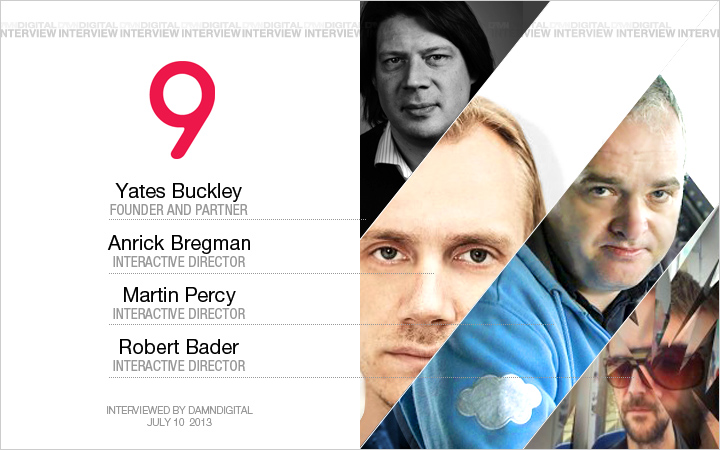
采訪&文字&翻譯: Viking Wong@dmunion.com
校對: Vivian Peng@dmunion.com
(原創(chuàng)內(nèi)容, 轉(zhuǎn)載請務(wù)必注明來自 數(shù)英網(wǎng) | DIGITALING)
本次的采訪主題,我們把主題聚焦在了“未來技術(shù)趨勢”,范圍再精準(zhǔn)些,就是那些我們時(shí)常掛在嘴邊討論的網(wǎng)站設(shè)計(jì)與移動(dòng)領(lǐng)域。喬布斯的蘋果給Flash潑了一盆冷水,WebGL技術(shù)的強(qiáng)大讓網(wǎng)站更加驚艷,“交互式”成為了項(xiàng)目制作的主旋律,“必須跨平臺(tái)”是每個(gè)設(shè)計(jì)師開發(fā)者們不得不考慮的問題??
當(dāng)然,沒有人會(huì)知道在接下來的幾個(gè)月或是未來的幾年里會(huì)發(fā)生些什么,但這并不阻礙我們對此做出自己的見解,或好或壞,也許只是來回地在原地繞了一圈。
來自UNIT9的三位互動(dòng)總監(jiān)ANRICK BREGMAN,MARTIN PERCY,ROBERT BADER以及擁有技術(shù)背景的founder之一YATES BUCKLEY作為我們本次采訪的對象,給出了很實(shí)在的回答——一切從我們能為用戶做些什么開始…
YATES BUCKLEY, UNIT9的創(chuàng)始人兼Partner

ANRICK BREGMAN, 互動(dòng)總監(jiān)
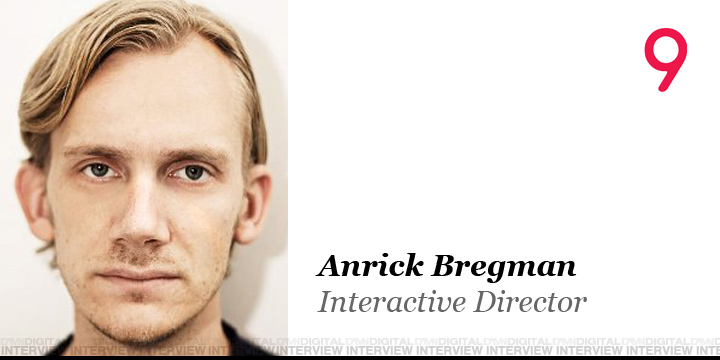
我加入U(xiǎn)NIT9有點(diǎn)偶然,那時(shí)我正在尋找更有挑戰(zhàn)性的工作,我很想涉及網(wǎng)站領(lǐng)域。我自學(xué)了編程,做實(shí)驗(yàn),嘗試著一些不同的東西。自己制作了作品集,投遞一些公司,然后某天的早上,我接到了來自UNIT9的電話。最初我作為創(chuàng)意加入到團(tuán)隊(duì),但現(xiàn)在,我成為了Freelance Director,這樣相對自由的關(guān)系給了我更大的創(chuàng)作空間。
MARTIN PERCY, 互動(dòng)總監(jiān)
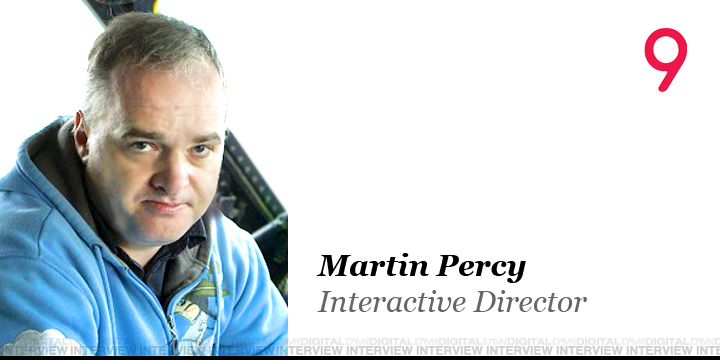
我是互動(dòng)電影總監(jiān)(interactive Film Director),我所要做的就是利用交互性和電影,創(chuàng)建網(wǎng)站及應(yīng)用程序。在與其他優(yōu)秀的創(chuàng)意人員的合作下,我很幸運(yùn)的榮獲三座Webby Awards(包括了2012最佳互動(dòng)視頻)、三次艾美獎(jiǎng)提名以及兩次BAFTA英國學(xué)院獎(jiǎng)提名。
ROBERT BADER, 互動(dòng)總監(jiān)
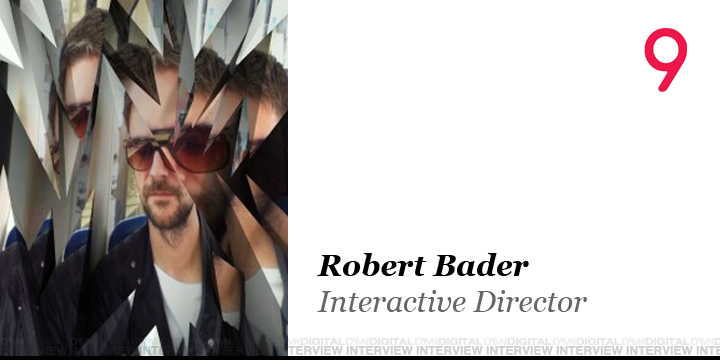
我在慕尼黑學(xué)習(xí)攝影,在2000年時(shí)去了倫敦,在那兒遇到了UNIT9的技術(shù)總監(jiān)Yates。那時(shí)的UNIT9規(guī)模不大,他們需要一個(gè)開發(fā)人員,于是我學(xué)會(huì)了PHP編碼。幾年后,我認(rèn)為自己需要接受一些新的挑戰(zhàn),讓自己更富創(chuàng)意性。幸運(yùn)的是,我不需要為此換公司,我被任命為互動(dòng)總監(jiān),我最新的一份冒險(xiǎn)就是開拓UNIT9在柏林的市場。
對于未來幾年里網(wǎng)站設(shè)計(jì)與技術(shù)發(fā)展趨勢的看法:
ANRICK BREGMAN:
如果讓我具體談?wù)劸W(wǎng)站建設(shè),那么我認(rèn)為我們在目前使用的技術(shù)上有點(diǎn)原地轉(zhuǎn)圈了。我想說,近來的焦點(diǎn)HTML5的確引發(fā)了不少的探討,但是這種努力又回到了我們在使用Flash時(shí)對于互動(dòng)的唯一標(biāo)準(zhǔn)。令人沮喪。
我預(yù)見到的趨勢之一是大量的創(chuàng)新和知識(shí)的共享,這可以看做是為彌補(bǔ)失去的時(shí)間而做的努力。當(dāng)你把技術(shù)人員放在像html5這樣相對較小的思維模式下,他們會(huì)開始快速地工作,快速地想出點(diǎn)子來擴(kuò)大這個(gè)思維模式,努力使它變得更強(qiáng)大更好,這是非常有趣的。在工作中看到革新的力量很棒。
|就未來趨勢而言,我認(rèn)為內(nèi)容分發(fā)(Content Distribution)會(huì)是今后的重點(diǎn)。
用戶如何在互聯(lián)網(wǎng)上找到好的東西?好內(nèi)容的制造者該如何從中獲益?無論是單純的實(shí)驗(yàn)性項(xiàng)目還是商業(yè)性質(zhì)的,我都應(yīng)該把目光放遠(yuǎn),把重點(diǎn)放在項(xiàng)目是以怎樣的方式最終呈現(xiàn),這就是所謂的內(nèi)容分發(fā)。我們有很多渠道用來分配內(nèi)容,但是就如何與這些渠道建立聯(lián)系,又該如何讓用戶找到你制造的內(nèi)容,談?wù)摰纳僦跎佟?br/>
MARTIN PERCY:
我認(rèn)為我們正處于一個(gè)非常有趣而又奇怪的時(shí)期,技術(shù)正逐漸變得政治化:從技術(shù)的角度來看,像HTML5技術(shù)不僅被視為一種有效的技術(shù)手段,更是一場政治化運(yùn)動(dòng)。人們在討論使用HTML5就像他們在討論為奧巴馬投票一樣,這讓技術(shù)討論變得復(fù)雜···
ROBERT BADER:
我猜二維設(shè)計(jì)的時(shí)代又要到來了?在過去的幾年里,互聯(lián)網(wǎng)制造了無限的可能性:從帶有故事性的網(wǎng)站設(shè)計(jì),到用戶體驗(yàn)還有內(nèi)容本身。一個(gè)好的設(shè)計(jì)應(yīng)該對內(nèi)容有助推的作用,并且能夠確保設(shè)計(jì)不會(huì)搶去內(nèi)容的風(fēng)頭。
在未來幾年中,網(wǎng)絡(luò)的發(fā)展對于目前用戶的使用情況而言,會(huì)有些什么影響?
YATES BUCKLEY:
這個(gè)問題我喜歡,因?yàn)樗婕暗降姆秶珡V,我們可以寫一本關(guān)于這方面的書了。我很想知道你們(中國)會(huì)給出什么樣的答案,我認(rèn)為你們的答案會(huì)比我豐富有趣的多。
我們正處在一個(gè)大型技術(shù)公司制造出的政治紛爭時(shí)期,而且我認(rèn)為消費(fèi)者為了趕上科技發(fā)展的步伐在這方面的經(jīng)濟(jì)花費(fèi)有點(diǎn)大。我很好奇,在這個(gè)體系創(chuàng)造出一片全新局面之前,它在集中技術(shù)影響力方面還能走多久。
如果帶寬增長并且保持在一個(gè)便宜的價(jià)位,我認(rèn)為將出現(xiàn)一個(gè)很有趣的階段。你可以試想一下,有一組在不同地方的人總是靠著視頻彼此相互聯(lián)系。這可能導(dǎo)致一個(gè)同步瀏覽的場景,我和你通過視頻整天連接,我們可以很輕易的選擇分享我們正在做的以及我們正在使用的網(wǎng)站。
最近有哪些重點(diǎn)關(guān)注的技術(shù):
ANRICK BREGMAN:
|我最近的一些項(xiàng)目都與WebGL技術(shù)有關(guān)。
動(dòng)畫是我職業(yè)生涯的開始,我真的非常熱愛它,現(xiàn)在又回到了動(dòng)畫上。雖然WebGL是個(gè)比較新的領(lǐng)域,但我可以使用許多經(jīng)典的動(dòng)畫訣竅令我感到異常的舒服,就像回到了家一樣。
除了這些項(xiàng)目,在未來的幾年中我也會(huì)嘗試執(zhí)導(dǎo)更多的拍攝項(xiàng)目。我很享受現(xiàn)場拍攝獨(dú)有的緊迫感和氣氛。那些在拍攝現(xiàn)場或工作室的日子的非常令我上癮,但也令我時(shí)刻提心吊膽著。
ROBERT BADER:
|WebGL技術(shù)的出現(xiàn)讓我們進(jìn)入了技術(shù)發(fā)展的另一樂章,特別是Google近期推出了它自己的渲染引擎Blink。
希望我們能避免新一輪的瀏覽器大戰(zhàn)吧。而令我印象最深刻的作品是《Find Your Way To Oz》,它展示了WebGL技術(shù)的無限可能性,從中我們可以看到未來技術(shù)的發(fā)展。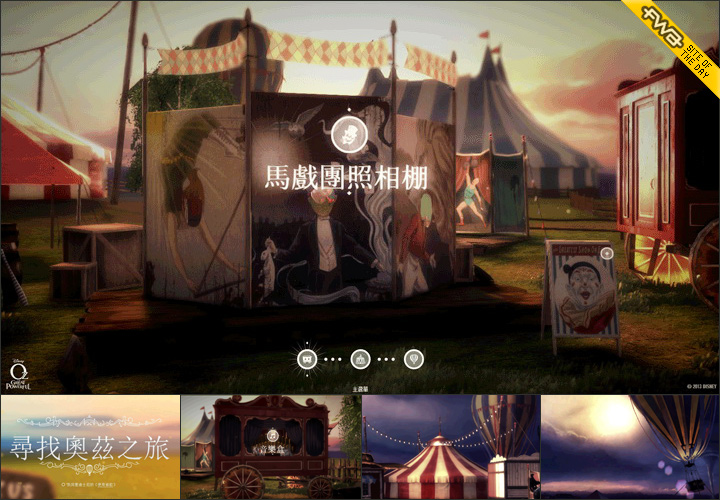
《Find Your Way To Oz》Casestudy on DamnDigital: http://www.damndigital.com/archives/83448
MARTIN PERCY:
(這里Martin發(fā)表了他對中國技術(shù)發(fā)展的看法)
很明顯歐洲的科技發(fā)展正陷入停滯期,與此同時(shí)中國正在向未來進(jìn)攻。
|我認(rèn)為中國成功創(chuàng)造了一個(gè)并不是由少數(shù)硅谷巨頭支配的數(shù)字空間,以此向全世界實(shí)現(xiàn)交互性的有效功能。
比如,比起twitter我更喜歡微博,理由之一就是能直接附加圖片,這從視覺上就變得更加有趣。另一個(gè)原因是中國語言的特質(zhì):同樣是140個(gè)字符,中文就能表達(dá)更多的內(nèi)容。
當(dāng)移動(dòng)設(shè)備日漸成為訪問互聯(lián)網(wǎng)最常見的終端時(shí),網(wǎng)頁設(shè)計(jì)師/開發(fā)者們不得不面對“如何跨平臺(tái)的呈現(xiàn)同樣網(wǎng)頁”這樣的挑戰(zhàn)。UNIT 9在這方面是否有自己的解決方案,或是可行性的建議嗎?
YATES BUCKLEY:
很抱歉,我們也找不到一個(gè)很好的辦法。或許只有當(dāng)確定并且限制了自己的研究領(lǐng)域后,才會(huì)找出更好的解決方案。如果我們可以創(chuàng)造出一些能重復(fù)利用的產(chǎn)品,或許我們能開發(fā)一些不錯(cuò)的跨平臺(tái)/跨瀏覽器的程序。
但遺憾的是UNIT9幾乎從未連續(xù)兩次有過同樣的工作。因此解決跨平臺(tái)的最好技術(shù),莫過于在項(xiàng)目一開始就對所有的平臺(tái)做一個(gè)徹底了解。幸運(yùn)的是,開發(fā)者可以借鑒以往他們在不同平臺(tái)上采用的技術(shù),我們不會(huì)強(qiáng)迫他們使用特定的工具。因此,所有涉及到跨平臺(tái)的關(guān)鍵因素往往來自團(tuán)隊(duì)人員自身對此的掌握。
當(dāng)開始著手創(chuàng)建一個(gè)網(wǎng)站時(shí),哪一部是你特別在意的?網(wǎng)頁設(shè)計(jì)、動(dòng)畫效果、UX或是你認(rèn)為最重要的部分?
ANRICK BREGMAN:
|我總是從最基本的結(jié)構(gòu)框架開始,就像電影必須有腳本一樣。
試著從用戶角度想象,他們將會(huì)如何瀏覽我創(chuàng)建的網(wǎng)站,然后思考他們在瀏覽網(wǎng)站時(shí)會(huì)這樣做,那樣做的原因。
MARTIN PERCY:
這些都不是。我更加關(guān)心終端用戶——我們該為他們做些什么?任何的一切都可以從這里獲得啟發(fā)。
互動(dòng)裝置,互動(dòng)視頻,互動(dòng)app…對于你而來“互動(dòng)”意味著?做好一個(gè)成功的online campaign,可否給些建設(shè)性意見。
ROBERT BADER:
|我把“互動(dòng)”一詞理解為用戶與所要傳達(dá)內(nèi)容之間的一個(gè)雙向的信息流動(dòng)。
這使它不同于電視。你不僅僅是消費(fèi)者,更多的是一個(gè)參與者。對我而言,因興趣而去參加,最終用戶能對所講述的故事感到好奇,被良好的用戶體驗(yàn)所吸引。一個(gè)好的campaign必須做到這一點(diǎn),獲得用戶的關(guān)注,讓他們在體驗(yàn)過后有想要分享的沖動(dòng)。
作過了HTML5項(xiàng)目,互動(dòng)視頻,應(yīng)用程序等的各種有趣的項(xiàng)目,接下來有想嘗試的不同領(lǐng)域嗎?
ANRICK BREGMAN:
拍攝領(lǐng)域無疑是我想花更多時(shí)間去摸索的方向。我認(rèn)為這是從情感層面接觸觀眾最直接,也是最有效的方法。當(dāng)我們看到別人的面部表情或是身體語言,或者觀察他們的情緒反應(yīng),我們的大腦就會(huì)做出強(qiáng)烈的反射。這對我來說是個(gè)有沖擊力的畫面。把實(shí)景拍攝于互動(dòng)元素結(jié)合,用有趣的手法表現(xiàn),我的目的就是改變用戶觀看的方式。
MARTIN PERCY:
我想我還是會(huì)繼續(xù)負(fù)責(zé)基于互動(dòng)性和電影的網(wǎng)站建設(shè)和app開發(fā)。這就是我想做的,并且做到更好…
我最近負(fù)責(zé)為英國復(fù)蘇委員會(huì)(Resuscitation Council UK)制作了一款交互式應(yīng)用《Lifesaver》,結(jié)合了真人電影與互動(dòng)游戲,模擬做CPR(心肺復(fù)蘇術(shù))的場景。通過移動(dòng)設(shè)備,用戶更能體會(huì)到此款應(yīng)用的樂趣。
《Lifesaver》Casestudy on DamnDigital: http://www.damndigital.com/archives/94252
當(dāng)然在問題的最后,我們也不會(huì)放過UNIT9作為一家擁有眾多創(chuàng)意人才,每年有不少佳作出產(chǎn)的Production Co.是如何管理自己的團(tuán)隊(duì),以及作為團(tuán)隊(duì)核心人員的3位總監(jiān)是如何保持自己的創(chuàng)意永遠(yuǎn)新鮮。
YATES BUCKLEY:
總的來說,UNIT9有超過50名員工,并且有一個(gè)十分活躍的工作網(wǎng)絡(luò)至少有100位團(tuán)隊(duì)人員經(jīng)常在一起工作。很難說公司的結(jié)構(gòu)屬于哪種,因?yàn)榇蟛糠值膯T工身處世界各地不同的地方,有著不一樣的專業(yè)及工作安排。
我們參與制作的項(xiàng)目無論是類型還是數(shù)量隨時(shí)都在變化,所以我們需要有一個(gè)非常靈活的工作架構(gòu),以此應(yīng)對任何可能發(fā)生的變化。我們保持公司結(jié)構(gòu)扁平化的管理方式,很少有中間的管理層,這樣一來,我們的團(tuán)隊(duì)就可以作為一個(gè)單元獨(dú)立工作。正因如此,我們在不同工作角色和專業(yè)性上沒做總體規(guī)劃,相反,我們會(huì)對不同的工作需要進(jìn)行有效的分配。
溝通是保持這一切運(yùn)作起來的重要元素,我們花大量的時(shí)間在交流上。我個(gè)人所扮演的角色就是努力保持員工之間在技術(shù),知識(shí)領(lǐng)域中得到交流。看看能否通過溝通上的改善,從而取得更好的效果。
ANRICK BREGMAN:
我花大把的時(shí)間在http://ffffound.com/ 上。這是我的弱項(xiàng)。花幾個(gè)小時(shí)瀏覽大量的圖片,可以給我靈感。當(dāng)然,我也喜歡去書店逛逛,無論是一般的書籍還是以設(shè)計(jì)為主。Magma這家位于倫敦的書店就是個(gè)不錯(cuò)的地方,值得我花幾個(gè)小時(shí)在那兒,穿梭在書架間。
最后,我最喜歡做的事情就是參加節(jié)日慶典。我不經(jīng)常參加,但上周,我去了貝爾格萊德,參加了在那兒舉行的Resonate——一個(gè)將程序代碼與藝術(shù)結(jié)合的新媒體大會(huì)。
MARTIN PERCY:
現(xiàn)實(shí)生活是我靈感的來源,因?yàn)槲艺J(rèn)為大部分好的互動(dòng)電影的基礎(chǔ)不在于你事先構(gòu)思故事情節(jié)然后試圖與受眾溝通互動(dòng),相反好的電影是基于現(xiàn)實(shí)活動(dòng),然后在此基礎(chǔ)上施以電影的拍攝手法和溝通技巧。所以,就像Bali Temple Explorer,它讓用戶探索現(xiàn)實(shí)生活;Lifesaver則讓用戶真切的體會(huì)做CRP的感覺。這樣的交互視頻才能賦予用戶更多情感上的體驗(yàn)。
我經(jīng)常瀏覽thefwa.com和awwwards.com。此外,我也會(huì)在YouTube上看看游戲的攻略,如果有趣,我就會(huì)去買。
ROBERT BADER:
我會(huì)定期瀏覽一下像Creative Applications Network或者TED這樣的網(wǎng)站。不過,出去走走,看看表演,旅游,結(jié)交新朋友是我靈感的主要來源。
UNIT9 Showreel 2012
****************************************
English Original:
Interview : a Glimpse into Future Technology Trends from UNIT9
Future technology trends seem a broad topic. But here we focus it on how the web design and technology will evolve over the next few years.
That’s right. Steve Jobs slammed Adobe Flash; WebGL changed the way animation used to be; cross-platform is always the question we should think about; “interactive” becomes the main theme of project making… Things in this industry change quickly.
Of course, nobody can know for sure what might happen in the coming months and years. But it does not deter us from giving an opinion on trends, for better or worse, maybe just going round in circles.
Here are the ideas from UNIT9, 3 interactive directors ANRICK BREGMAN,MARTIN PERCY,ROBERT BADER and YATES BUCKLEY, founder and partner of UNIT9, who have technical background.
Interviewee:
YATES BUCKLEY Founder and Partner of UNIT9
ANRICK BREGMAN, Interactive Director
I found UNIT9 quite randomly, while searching for a new challenge. I always wanted to work on websites and I was teaching myself to code, making experiments and trying out different things. I used to make small portfolio pieces for myself, and then I sent those out to a few companies, with the idea of working for them. One morning I got a call from the guys at UNIT9 and the rest, as they say, is history.
That was six years ago. Initially I joined as an all-round creative but within a year I had switched roles, to my current position as a freelance director, with UNIT9 working as my representative.
MARTIN PERCY, Interactive Director
I’m an interactive Film Director – everything I do is about creating websites and applications which use interactivity and film. By working with some great people, I’ve been lucky enough to win three Webby Awards (including for best interactive video 2012), three Emmy nominations and two BAFTA British Academy Award nominations.
ROBERT BADER, Interactive Director
I’ve studied photography in Munich, moved to London in 2000 and met UNIT9‘s Technical Director Yates in a pub. UNIT9 was very small back then, they needed a developer, so I learned how to code PHP. A few years later I needed a new challenge and be more creative again. Luckily I didn’t have to change company for that, I was offered a job as Interactive Director. My latest adventure is opening UNIT9 Berlin.
What trends do you see coming in the near future in design? What about in technologies?
ANRICK BREGMAN:
If I talk specifically about websites, then I think we are going round in circles a little bit with the technology that is in use. I’d say that the focus lately on html5 has sparked a lot of hard work, but that effort has all been about trying to return to the same standard of interaction that we were used to seeing in Flash. So that’s frustrating.
One of the trends I see coming out of that is a huge amount of innovation and sharing of knowledge; a kind of race to make up for lost time. It’s interesting when you put technology people into a smaller box – like html5 – because all of a sudden we all start to work very quickly to come up with solutions to make that box larger, to expand it, and to try to get it to be better. It’s beautiful to see innovation at work.
In terms of future trends, I think the focus should be on distribute content. How can audiences find something amazing on the internet? And how can the maker of that amazing piece of content benefit? Whether it is an experiment or something commercial, we should go beyond the context, and focus on where this project will end up ie; distribution. We have so many channels to distribute to but very little structure in terms of how to reach those channels, and very little structure in terms of getting an audience to find your work.
MARTIN PERCY:
I think we’re in a very interesting but rather strange period where technology has become entangled with politics: so a technology like HTML5 is not just regarded as effective technology from a technical point of view, but as a politically virtuous movement. People say they use HTML5 like they say they’re voting for Obama. Which can make technical discussions rather complex…
ROBERT BADER:
I guess it’s time for more 2D design again? What’s possible online has changed a lot in the last few years: it’s all about the story, the experience, the content itself. A good design should promote the content and almost go unnoticed.
In technology webGL was a very exciting movement until Google recently announced to create their own fork called Blink. Let’s hope we can avoid a new round of browser wars.
And how do you think the web will evolve in the next few years?
YATES BUCKLEY:
This is a question I love, because it’s actually so broad we could write a book about this. I would be so curious to find the answer from someone in China and I think their answer would be much more qualified than mine.
We are in a period of political strife among big technology companies and I think the customers are paying the price a bit. I am curious how far the system will be able to go in trying to centralise technical influence before it creates an opportunity for something completely new to transform the landscape.
If bandwidth grows and stays cheap I think there will be a very interesting phase, something like video connections between groups of people in different places that are always on. This would lead to a co-browsing type scenario where me and you are there all day connected on video but we also can easily choose to share what we are doing, the websites we are using.
More recently, is there any technology that you have focused on?
ANRICK BREGMAN:
My most recent project was in WebGL, and that was very exciting for me. I started my career in animation and I have always had a real love for animation, so to return to it was wonderful. It created this sense of excitement, because even though WebGL is fairly new I was using so many classic animation tricks which just felt incredibly comfortable, almost like being at home.
But apart from that project, I am super excited about directing more shoots over the next few years. I love the atmosphere and sense of urgency of live shoots; there’s an intensity about the days you are on location or in a studio that is extremely addictive, but also very scary.
ROBERT BADER:
In technology webGL was a very exciting movement until Google recently announced to create their own fork called Blink. Let’s hope we can avoid a new round of browser wars.
《Find Your Way To Oz》Casestudy on DamnDigital: http://www.damndigital.com/archives/83448
Mobile devices are a key consideration when building a site. But cross-platform seems a ‘trouble guy’ for developers to deal with. Does UNIT9 itself have a better process way?
YATES BUCKLEY:
We unfortunately can’t really find a better way. This is because a better way exists only when you stabilize and limit the field you are working on. If we created products that could be recreated many times we would be able to set some nice procedures across platforms / browsers.
But UNIT9 unfortunately almost never gets the same job 2 times in a row. So the best technique we have to figure out cross-platform is to just to review all the platforms at the outset of a job. Developers do have tricks to reuse parts of their past work for different platforms luckily, but we don’t force them to use a particular tool. So all the key considerations relating to cross-platform tend to come from the team.
When you start to create a website, what part do you most focus on? Web design, animation effect, UX or maybe others?
ANRICK BREGMAN:
I always start with a script, almost like a film. Even if that website is purely functional you can always write a script for it; trying to imagine how the user would travel through this website I am going to create, and thinking about the reasons why they might make a decision to go this way, or that way.
MARTIN PERCY:
None of those. I think about the end-users – what are we trying to do for them. Everything else should spring from that.
Interactive installation, Interactive video… so what does ‘interactive’ mean to you?To make a successful online campaign, do you have some thoughtful suggestions ?
ROBERT BADER:
The definition of interactive is allowing a two-way flow of information between it and a user. It’s what makes it different to TV. You don’t just consume, you take part. But for me to be interested in taking part, I have to be drawn into an experience, be made curious about the story. A good campaign will manage to do that, get the user’s attention and entertain to the point that they want to share it.
You have been done a variety of projects including HTML5 project, interactive film, application etc. Are there any other fields that you want to try next?
MARTIN PERCY:
I direct websites and apps based around interactivity and film. That’s all I want to do – I just want to do them better…
The works Lifesaver is recently I work on. It’s an action movie with a simple game in it where you choose what the hero does. But by playing it, you learn how to save someone’s life if they were to choke or have a cardiac arrest. I say it’s based around interactivity and film.
《Lifesaver》Casestudy on DamnDigital: http://www.damndigital.com/archives/94252
ANRICK BREGMAN:
Filming is definitely a field that I want to explore more. I think it’s the most powerful way to reach your audience on an emotional level. Our brains make the strongest connection when we are watching another human’s facial expressions or body language, or when we are observing their emotional responses. This is an awfully powerful image for me. By mixing live action with interactive elements, in playful ways, my aim is to change the way people watch.
Finally,as a production company, with so many creative talents, we are still curious about that how do UNIT9 manage their team and how the three interactive directors get their inspirations, keeping creative fresh.
How many staff are employed by UNIT9 and more specifically how many designers/ developers are there and what do their roles entail?
YATES BUCKLEY:
Overall we are more than 50, and an active production network that is at least 100 people regularly working together. It’s hard to convey our structure though because many people are around the world in different places, and have different specialties and working arrangements with us.
The kind and number of projects we are producing is changing all the time, so we need to have a very flexible structure that can react to anything that might come in. We keep a very flat company structure, there is little intermediate management and our teams can work independently as units. Because of this we don’t really have an overall plan of the different roles and specialties, instead we evolve to what is needed for a particular job.
The glue to keep all this running is communication – we spend a lot of time communicating. My personal role is more about trying to see that the experts are aware of knowledge that another expert might have. To see if by improving communication we can achieve a better result.
How do you do to get inspirations? List 3 places.
ANRICK BREGMAN:
I spend an awful lot of time of http://ffffound.com/. This is my weakness. I spend hours scrolling through copious amounts of images, admiring the beautiful and extraordinary inspirational work. Secondly, I love going to bookshops; whether they are traditional ones or design focused. Magma, based in London, is a wonderful example of a beautiful shop where I can be found for hours, trawling through bookshelves, admiring all the exquisite work people are producing.
Finally, one of my favourite things to do is to attend festivals. I don’t get to do this very often, but last week I went to Resonate, New Media Festival in Belgrade. Resonate manages to bring together code and art in a really inspiring way.
MARTIN PERCY:
REAL LIFE is my great inspiration: because the basis for most good interactive films is this: don’t think of a story and make it interactive; rather, think of a real-world activity, and model it with film and interactivity. So, the Bali Temple Explorer is a bit like exploring a place in real life. Lifesaver is a bit like doing CPR or saving someone from choking. This way you get interactive film experiences which are more emotional and more instinctive.
As well as that, to keep current, I look at thefwa.com and awwwards.com most days; I also play walkthroughs of console games on YouTube, and if I find the game interesting enough I’ll buy it.
ROBERT BADER:
There are a few websites like Creative Applications Network or TED that I check regularly, but I get my inspiration mainly from going out, seeing shows, traveling and meeting people.
轉(zhuǎn)載請?jiān)谖恼麻_頭和結(jié)尾顯眼處標(biāo)注:作者、出處和鏈接。不按規(guī)范轉(zhuǎn)載侵權(quán)必究。
未經(jīng)授權(quán)嚴(yán)禁轉(zhuǎn)載,授權(quán)事宜請聯(lián)系作者本人,侵權(quán)必究。
本文禁止轉(zhuǎn)載,侵權(quán)必究。
授權(quán)事宜請至數(shù)英微信公眾號(hào)(ID: digitaling) 后臺(tái)授權(quán),侵權(quán)必究。




評論
評論
推薦評論
暫無評論哦,快來評論一下吧!
全部評論(0條)